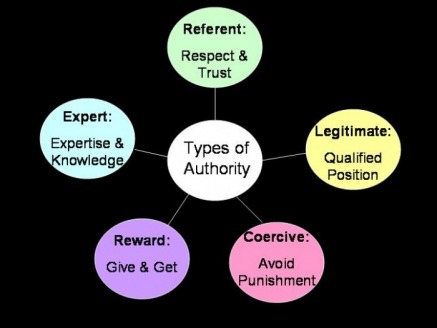Authority/ Leadership

Establishing teacher leadership and authority is another pivotal component to a happy and healthy classroom. Understanding the various types of leadership leads to self-awareness and better teaching.
Description:
Building on the concept of lead management, (discussed under the management and discipline link) leadership exhibits all of these qualities mentioned therein. It uses its position to affect whole-child growth. These leaders show respect for others, are credible, consistent, honest, competent and inspiring. They also have a clear sense of direction, care for others, are trustworthy, good models, fun and lifelong learners. Though there are many qualities for the teacher to grow in, these characteristics create a positive learning environment.
Authority, then, is, “the right to give commands, enforce obedience, or make decisions” (Savage, 1999). This is a broad spectrum, however, and it is often more helpful to break authority types into five categories, legitimate, reward, coercive, expert and referent. (All will be discussed in greater detail in the components portion of this page.) Knowing where and when to use each can lead to more effective teaching.
Significance:
Like management and discipline, authority and leadership are essential concepts in the composite of teaching. Having a working knowledge of leadership qualities (as well as striving to exhibit them) and types of authority aid in the teacher’s ability to manage and discipline effectively.
Demonstration:
The following hypothetical example may help illustrate the importance of effective authority and leadership. In a second grade class, a student exhibits poor behavioral choices. He continually talks to others around him and disrupts the class. Instead of working with this child using good leadership techniques, the teacher tells him to behave many times. Yet his behavior continues. After taking a course in classroom management and discipline, the teacher tries a different approach. She spends time to find out the student’s interests, disinterests and concerns and takes them into account in her instructional time. She also begins praising him any time he is quietly working and refrains from verbal reminders instead quietly coming over to him as a reminder of what his task is. She is essentially giving him the choice to behave, and build self-control. Within weeks, his behavior has dramatically improved, due, in part, to the change in her leadership and authority styles.
Integral Components:
As mentioned above, leadership is marked by integrity, shared power, trust, credibility, and consistency. Students are involved in making decisions (such as class rules, etc.) and the teacher is clear in communicating expectations. Students are also involved in self-analysis where the teacher is a facilitator. Power is shared, in that students have responsibilities in the class as delegated (and rotated). Essentially, there is a sense of community among the class and teachers. (Savage, 1999)
Authority is marked by five styles. The first is legitimate authority. Predominately useful at the beginning of the year, it implies that the teacher’s position qualifies them to be the authority figure. While useful in the beginning, it is best switch methods thereafter because this method is not best for fostering student self-control. It can lead to low student input and blind obedience. A second type of authority is reward. Similar to a behaviorist model in psychology, it uses tangible rewards to a job well done. The power lies in the ability to give rewards to get what the teacher wants. This may be used with substitutes or other situations where there has not been enough time to know the students well. Like legitimate authority, it does not promote self-control as well because rewards are given for positive behavior, thus the motivation is the reward itself. (Even grades can be considered a reward as can verbal praise.) However, this is useful at certain times, and when in the process of building relationships.
Coercive authority is essentially the opposite of reward authority. It uses punishment and the threat of punishment as a means of authority. This is best used in extreme situations, when a student has lost control. However, in daily use, it can create power struggles, anger, resistance, etc. It is a once and a while tool. Expert authority is based on the idea that the teacher has authority due to their expertise or knowledge. It is beneficial in that this is an earned authority and is founded in respect. It can be of greater difficulty for new teachers because it requires much confidence and self-assurance. Finally, the last form of authority is referent. Often one of the best forms of authority, a referent leader has earned their place because of the leadership qualities. They are respected and trusted, and they have the students’ best interest in mind. Tips to earn this include, learning students’ names quickly, being genuine in praise, avoiding humiliation and sarcasm, and being fair and consistent (Savage, 1999).
Individualization:
Understanding oneself is an important part to teaching. If we are not aware of our motives and actions, we can subliminally send unintentional messages. However, there is strength in understanding one’s views and self. In my own experience, I hope to use this to become a referent leader, modeling a Christ-like character to my students.
Spiritual Application:
The qualities of a leader and referent authority are consistent with the Biblical characteristics exhibited in the Christian life. The entire book of Proverbs is a testament to this. Just one example is Proverbs 10:9, which states that the individual without integrity will be found out. (Another example of the importance of integrity is that Jesus himself was a man of integrity as seen in Matthew 22:16 and Mark12:14.) One of my favorite passages from Colossians sums up the qualities of a Christian referent leader well, "therefore, as the elect of God, holy and beloved, put on tender mercies, kindness, humility, meekness, longsuffering; bearing with one another, and forgiving one another, if anyone has a complaint against another; even as Christ forgave you, so you also must do. But above all these things put on love, which is the bond of perfection. And let the peace of God rule in your hearts, to which also you were called in one body; and be thankful. Let the word of Christ dwell in you richly in all wisdom, teaching and admonishing one another in psalms and hymns and spiritual songs, singing with grace in your hearts to the Lord. And whatever you do in word or deed, do all in the name of the Lord Jesus, giving thanks to God the Father through Him" (Colossians 3: 12-17 NKJV). As Christians, we are to love our neighbors (everyone) selflessly. As teachers, we do not leave this responsibility, but utilize it to best care for the children in our class.



